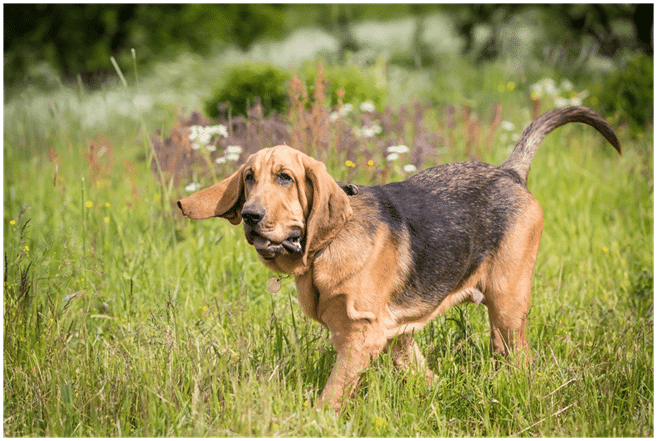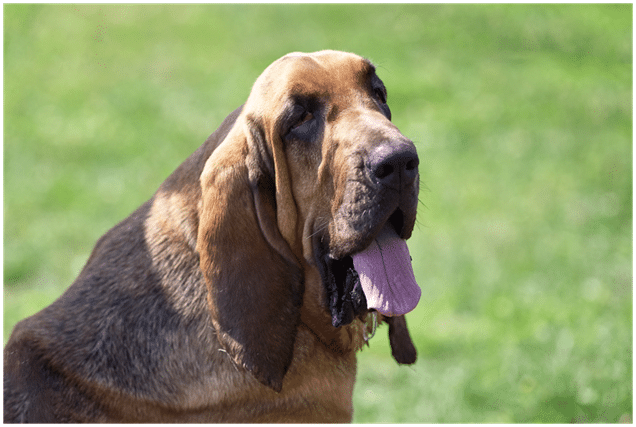The Bloodhound is notorious for their love of peeing, which can present a challenge for its owners. In this article, we’ll take a closer look at why Bloodhounds tend to pee so much and offer some tips on how to manage it.
Bloodhounds pee at least twice per day, and much more often when they are puppies. Their peeing frequency will increase if they drink too much water or don’t have enough exercise. Excessive peeing could also be a sign of health issues with your Bloodhound.
When do Bloodhound puppies stop peeing in the house?
Many people may wonder if Bloodhounds are high maintenance because of their need to pee frequently. The answer is, not really. Bloodhound puppies usually stop peeing in the house at around 6 months old. However, each dog is different, so some may take a bit longer to train.
Why is my Bloodhound puppy peeing every 15 minutes?
If your Bloodhound puppy is only peeing every 15 minutes, then it’s probably not anything to worry about. Most puppies this young will need to pee frequently because their bladders are still small. As they get older, their bladder will grow and they’ll naturally go longer between bathroom breaks.
Once your puppy becomes an adult, peeing every 15 minutes is definitely a cause for concern. If this is the case, you’ll want to take him or her to the vet to rule out any health problems.
Why is my Bloodhound puppy peeing so much all of a sudden?
If your Bloodhound puppy has suddenly started peeing a lot, there are six possible reasons this could be occurring, including:
Excitement urination
Excitement urination is the most common reason for frequent urination in bloodhounds. When they get excited, their body releases a hormone called adrenaline.
This hormone makes them pee more frequently. Similarly, when bloodhounds exercise they typically drink large amounts of water. Their excessive drinking through exercise and excitement can cause frequent urination.
Submissive urination
Submissive urination is another common reason for increased urination in bloodhounds. When they feel scared or intimidated, their body releases a hormone called cortisol.
Medical conditions
A number of medical or health conditions can also cause increased urination in bloodhounds.
Some medical conditions that can cause increased urination are diabetes, urinary tract infection, uterine infection, bladder infection, diabetes mellitus, urinary incontinence, renal failure, kidney disease, or kidney failure.
Age
Age can also cause increased urination in bloodhounds. As they get older, their kidneys don’t work as well and they may not be able to hold their urine as long.
Anxiety
An increase in anxiety may cause increased urination in bloodhounds. Dogs with separation anxiety are a good example. If they are anxious or stressed, their body may release a hormone called cortisol. Cortisol will often trigger their need to pee more often.
Overhydration
Overhydration can also cause increased urination in bloodhounds. If they drink too much water, their kidneys will try to get rid of the excess water by excreting urine.
Are Bloodhounds hard to house train?
No, Bloodhounds are actually quite easy to house train. Like most puppies, they will need to be potty trained regularly, but with a bit of patience and consistency, they will learn where to go.
The key to housetraining your Bloodhound is to be patient and to take them outside regularly (every 15-20 minutes). When they do go to the bathroom, make sure to praise them enthusiastically so they know that they did the right thing.
On some rare occasions, Bloodhounds may be challenging to house train if they have a strong will or if they’re not getting enough exercise. If you’re having trouble house training your Bloodhound, consult with a professional trainer for assistance.
Can you train a Bloodhound not to pee as much?

While it’s not impossible, it is difficult to train a Bloodhound not to pee as much. These dogs are bred for their strong sense of smell, and so they tend to need to pee more than other breeds.
However, with a bit of patience and persistence, you can teach them where to go so they don’t pee in the house.
A simple method to train your Bloodhound to pee less often is to restrict their water intake. This will help to reduce the number of times they need to go to the bathroom.
Alternatively, you could try to exercise them more, as this will help them to use up some of their energy and reduce the number of times they need to pee.
How much do Bloodhounds pee and poop?
On average, Bloodhounds will pee and poop about twice a day. However, this can vary depending on how much they drink, how active they are, and whether or not they’re teething.
If you feed your Bloodhound a diet of wet food, they will likely need to go pee more often. This is due to wet food containing a lot of water.
Your Bloodhound will poop more often if they’re eating a diet of dry food. This is because this type of food is harder to digest. Table scraps and other people’s food can also make your Bloodhound poop more often.
The other factor to watch out for is the quality of your Bloodhound’s poop. If it’s soft, watery, or has mucous in it, this may be a sign that your dog is sick. You should take them to a veterinarian if this happens.
On the contrary, if their poop is hard and dry, this may be a sign that they’re not getting enough water.
The color of your dog’s poop can also be a sign of health problems. Black or tarry poop can be a sign of blood in their stool, while very light-colored poop can be a sign of liver problems.
You should therefore keep an eye out for your Bloodhound’s poop. If you notice any unusual changes, take them to the veterinarian for a check-up.
What should you do if your Bloodhound starts peeing or pooping in the house?
If your Bloodhound starts peeing or pooping in the house, the first thing you should do is determine what’s causing them to do this. Once you’ve identified the root of the problem, you can then take steps to correct it.
If your Bloodhound has a UTI, for example, it will need to be treated by a veterinarian.
“The other issue is that your Bloodhound may be drinking too much water, so you may need to limit their access to water.“
Finally, if your Bloodhound isn’t house-trained yet, you will need to start potty training them immediately.
The best way to prevent your Bloodhound from peeing and pooping in the house is to be patient and to take them outside regularly. With a bit of effort and patience, you can train your Bloodhound to pee and poop in the right places.
How to potty train your Bloodhound puppy?

If you’re looking to potty train your Bloodhound puppy, here are some tips that may help:
Take them outside regularly (every 15-20 minutes). When they do go to the bathroom, make sure to praise them enthusiastically so they know that they did the right thing.
If you’re not able to take them outside, put them in a designated bathroom area (preferably outdoors) where you can keep an eye on them.
If your puppy has an accident in the house, make sure to clean it up immediately so they don’t get the wrong idea.
Be patient and consistent with your training, and don’t get frustrated if your puppy doesn’t learn right away.
By following these tips, you can help your Bloodhound puppy learn where to go when they need to pee or poop.
How to Prevent Urine Marking Behavior?
Many Bloodhounds will start to urine mark (or squat) in the house as they reach sexual maturity. This is a way for them to communicate their dominance and territory.
There are a few things you can do to help prevent your Bloodhound from urine marking:
Make sure your Bloodhound has plenty of places to pee and poop outside, and that they’re going potty in the right places.
If your Bloodhound is marking in the house, place them in a timeout (in their crate or another room) until they stop.
- Reward your Bloodhound when they go outside to pee or poop.
- Avoid letting unfamiliar people or animals come into your home.
- Keep your Bloodhound’s living space clean and free of odors
These tips should help to reduce the likelihood of your Bloodhound urine marking in the house.
Tips for keeping your Bloodhound’s bathroom area clean and odor-free
Use a litter box if your Bloodhound is peeing in the house. This will help to contain the mess and will make clean-up easier.
If you’re using a litter box, make sure to change the litter regularly so it doesn’t get too stinky.
If your dog is pooping in the house, you may want to consider using a doggy potty pad or some other type of absorbent material.
Keep your Bloodhound’s bathroom area clean and free of clutter, so it’s easy to spot any accidents that may happen.
By following these tips, your should be able to keep your Bloodhound’s bathroom area clean and odor-free.
Should you Rub a Dog’s Nose in Pee?
Some people believe that you should rub a dog’s nose in their pee to punish them for going in the wrong place. However, this is actually not an effective way to train your dog, and can actually make things worse.
Rubbing your dog’s nose in pee can cause your dog to become confused. It will also make them reluctant to pee in front of you. It can also lead to potty training accidents in other parts of the house.
If you catch your Bloodhound peeing in the wrong place, calmly say “No” and take them outside to finish their business. If you consistently praise your dog when they go outside to pee or poop, they will learn to associate these behaviors with good things.
And, most importantly, be patient while training them. It may take a little while but it will be worth it in the end.


